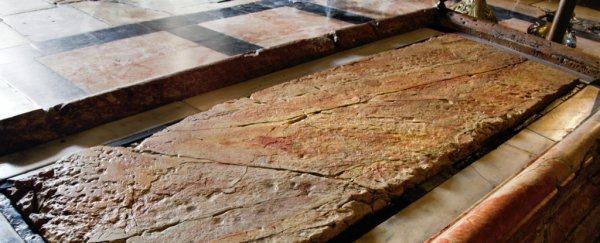The tomb in which Jesus Christ is believed to be buried is older than everybody thought, scientists have revealed.
Tests run on the remains of a limestone cave in the Church of the Holy Sepulchre in Jerusalem have dated the tomb to around 345 CE, National Geographic reported on Tuesday.
The cave, the oldest architectural remnant on the site, is therefore 1,700 years old. The scientific process analysed chemicals in the remains to find out how long it had been since they were last exposed to light.
Previous architectural evidence found around the site had dated only to the Crusader period, around 1,000 years ago.
The vault is widely believed to be the site of Jesus' crucifixion, burial, and resurrection, referred to in the Bible as Calvary or Golgotha. An archaeological study on the site last year found that the tomb had never been moved.
While the New Testament says Jesus died either in 30 or 33 CE, historical accounts suggest that Romans located and enshrined the tomb in 326 CE.
The date corresponds to the rule of Constantine I, the Roman emperor who converted to Christianity and declared it an accepted religion of the empire. From this point it became more common to build large monuments to Christ.
The tomb was totally destroyed and subsequently rebuilt in the year 1009, prompting historians to doubt whether the Church of the Holy Sepulchre was the same burial site discovered by the Romans.
However, the latest scientific tests, carried out for over a year by the National Technical University of Athens, have suggested otherwise.
The technique used is called optically stimulated luminescence (OSL), National Geographic said. It determines how recently quartz sediment in samples from the tomb's mortar were exposed to light.
The magazine said the results will be published in full in a forthcoming archaeological journal.
The tomb was opened to the public for the first time in centuries last October, when scientists began restoring a shrine enclosing the tomb, also known as the Edicule.
The nine-month restoration project took US$4 million (£3.3 million), The Guardian reported.
While it remains archaeologically impossible to say the tomb belonged to Jesus of Nazareth, the Church of the Holy Sepulchre is the most widely accepted site of Christ's burial.
Dan Bahat, former city archaeologist of Jerusalem, previously said: "We may not be absolutely certain that the Holy Sepulchre Church is the site of Jesus' burial, but we certainly have no other site that can lay a claim nearly as weighty."
This article was originally published by Business Insider.
